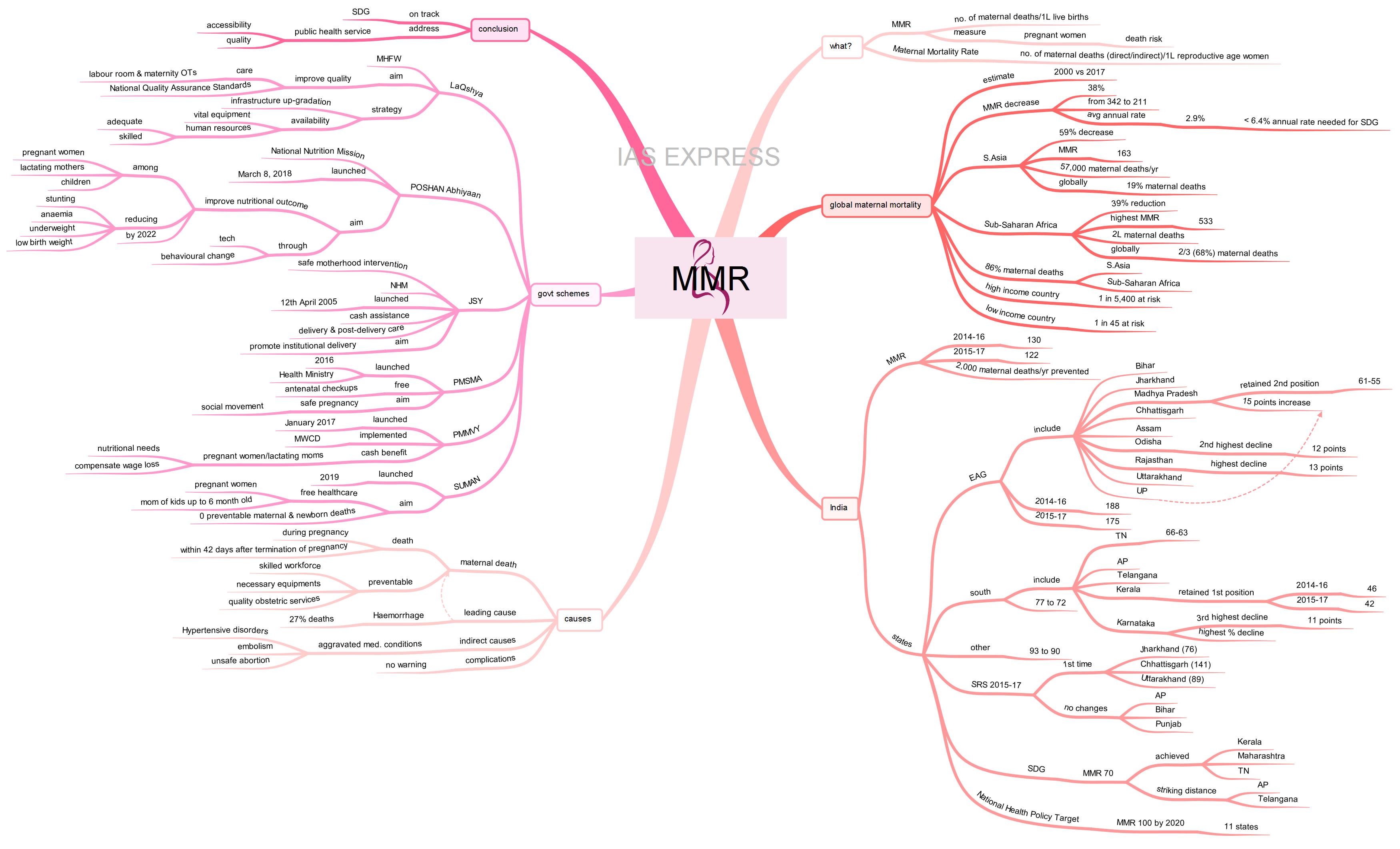Maternal Mortality Ratio (MMR) in India – Reasons & Responses

From Current Affairs Notes for UPSC » Editorials & In-depths » This topic
IAS EXPRESS Vs UPSC Prelims 2024: 85+ questions reflected
According to the recently released Sample Registration System (SRS), India’s Maternal Mortality Ratio has declined from 130 per 1 lakh live births in 2014-16 to 122 per 1 lakh live births in 2015-17. This is of significance as it means that about 2,000 maternal deaths have been prevented each year. This may be due to the improving accessibility and affordability to healthcare and also due to increasing awareness about the benefits of the public health system.
What is the Maternal Mortality Ratio (MMR)?
- Maternal Mortality ratio is often used interchangeably with the maternal mortality rate.
- However, the World Health Organisation has distinguished between these two indicators of maternal deaths.
- Maternal Mortality Ratio (MMR) is the number of maternal deaths per 1,00,000 live births. It is a measure of the risk of death once a woman has become pregnant.
- Maternal Mortality Rate is the number of maternal deaths (direct and indirect) in a given period per 1,00,000 women of reproductive age during the same period.
What is the global maternal mortality trend between 2000 and 2017?
- According to the UN inter-agency estimates, from 2000 to 2017, the global maternal mortality ratio decreased by 38% – from 342 deaths to 211 deaths per 1,00,000 live births.
- This means that the average annual rate of reduction is 2.9%, which is less than half the 6.4% annual rate needed to achieve the Sustainable Development Goal of 70 maternal deaths per 1 lakh live births.
- There has been significant progress since 2000.
- Between 2000 and 2017, South Asia achieved the highest overall percentage reduction in MMR, with a reduction of 59%.
- Sub-Saharan Africa achieved a substantial reduction of 39% of maternal mortality during the same period.
- Sub-Saharan Africa and South Asia account for 86% of maternal deaths worldwide.
- Sub-Saharan Africans suffer from the highest maternal mortality ratio – 533 maternal deaths per 1 lakh live births or 2,00,000 maternal deaths per year. This is over two thirds (68%) of all the maternal deaths per year worldwide.
- South Asia follows, with a maternal mortality ratio of 163 or 57,000 maternal deaths per year, accounting for 19% of the global total.
- Furthermore, regional and global averages tend to mask the large disparities both within and between these countries.
- Also, the lifetime risk of maternal death in high-income countries is 1 in 5,400, compared to 1 in 45 in low-income.
- The global lifetime risk of maternal death nearly halved between 2000 and 2017, from 1 in 100 to 1 in 190.
What is India’s Maternal Mortality Ratio?
- As per the Sample Registration System, India’s Maternal Mortality Ratio has declined from 130 per 1 lakh live births in 2014-16 to 122 per 1 lakh live births in 2015-17.
- This is good news for India as nearly 2,000 maternal deaths have been averted each year according to the bulletin.
- A sample of 64,75,970 females between age 15 and 49 years was studied in 2015-17. While there were about 4,29,173 live births in this population, 525 mothers died during this time.
- Maternal deaths being a rare event require prohibitively larger sample size to provide robust estimates.
- To enhance the SRS sample size, the results have been derived by following the practice of pooling three years of data to yield reliable estimates of maternal mortality.
State-wise analysis:
- For the better understanding of the maternal mortality situation in India and to analyse the progress that is being made at the regional level, the government has categorised the states into three groups – Empowered Action Group (EAG), the South States and the Other States.
- Bihar, Jharkhand, Madhya Pradesh, Chhattisgarh, Odisha, Rajasthan, Uttar Pradesh, Uttarakhand and Assam come under the EAG.
- Andhra Pradesh, Telangana, Karnataka, Kerala and Tamil Nadu come under the South States group.
- “Others” consist of all the remaining states and Union Territories.
- The MMR decline has been most significant in EAG states from 188 (2014-16) to 175 (2015-17)
- The ratio has also reduced from 77 to 72 among the southern states and in other states from 93 to 90.
- The SRS 2015-17, for the first time, released an independent MMR data for Jharkhand (76), Chhattisgarh (141) and Uttarakhand (89).
- Rajasthan’s MMR has shown the highest decline by 13 points and is followed by Odisha (12 points) and Karnataka (11 points).
- The states of Andhra Pradesh, Bihar and Punjab have not shown any changes in the ratio.
- Kerala retained its first position. It had reduced its MMR from 46 in 2014-16 to 42 in 2015-17.
- Similarly, Maharashtra retained its second position with 55 (down from 61) and Tamil Nadu retained its third position with 63 (down from 66).
- Karnataka showed the highest percentage decline in MMR and Uttar Pradesh and Madhya Pradesh have shown an increase by 15 points each in MMR.
- Kerala, Maharashtra and Tamil Nadu have already met the Sustainable Development Goal targets of 70 per 1 lakh MMR, while Andhra Pradesh and Telangana are within “striking distance”.
- 11 states have achieved the National Health Policy Target of MMR 100 per 1 lakh live births well ahead of 2020.
What causes maternal death?
- Maternal death is the death of women during the pregnancy or within 42 days of termination of pregnancy.
- Globally, Haemorrhage remains the leading cause of maternal mortality, accounting to about one quarter (27%) of deaths.
- A similar proportion of maternal deaths were caused indirectly by pre-existing medical conditions aggravated by the pregnancy.
- Hypertensive disorders (high blood pressure disorders) of pregnancy, especially eclampsia as well as sepsis, embolism and complication of unsafe abortion also claim a substantial number of lives.
- The complication leading to maternal death can occur without warning at any time during the pregnancy and childbirth.
- Most maternal deaths are preventable if births are attended by skilled personnel (doctors, nurses or midwives) who are regularly supervised and have the proper equipment and supplies and can refer women promptly to emergency obstetric care when complications are diagnosed.
- Complications require immediate access to quality obstetric services equipped with life-saving drugs, including antibiotics, and the ability to provide blood transfusions needed to perform Caesarean section or other surgical interventions.
Why is there a decline in MMR in India?
Improved quality and coverage of health services through government initiatives have led to the fall in the maternal mortality rate. Some of the government initiatives are as follows:
LaQshya:
- The Union Ministry of Health and Family Welfare launched the Labour room Quality Improvement Initiative (LaQshya).
- It aims to improve the quality of care in the labour room and maternity operation theatres in public health facilities.
- This is to reduce the preventable maternal and newborn deaths, morbidity and stillbirths.
- A comprehensive strategy has been adopted that includes infrastructure up-gradation, ensuring the availability of vital equipment, improved and adequate human resources and improving skills of healthcare workers.
- The quality of the labour rooms and maternity operation theatres will be assessed through the National Quality Assurance Standards (NQAS).
POSHAN Abhiyaan (National Nutrition Mission)
- It was launched on March 8, 2018, to improve nutritional outcomes among pregnant women, lactating mothers and children by reducing the level of stunting, underweight, anaemia and low birth weight by 2022.
- It aims to ensure service delivery and interventions through technology, behavioural change through convergence. It lays down specific targets that are to be achieved based on different parameters
Janani Suraksha Yojana (JSY):
- It is a safe motherhood intervention under the National Health Mission (NHM).
- Launched on 12th April 2005, it is a 100% centrally sponsored scheme that is being implemented across all states and Union Territories with special focus on low performing states.
- It integrates cash assistance with delivery and post-delivery care to reduce the maternal and neonatal mortality rate and promote institutional delivery of the pregnant women, especially with weak socio-economic status.
Pradhan Mantri Surakhit Matritva Abhiyan (PMSMA):
- It was launched in 2016 by the Health Ministry to provide free comprehensive and quality antenatal checkups for pregnant women across the country.
- It aims to make safe pregnancy a social movement across the country.
- Since its launch is successful in conducting more than 25 lakh check-ups in high-priority districts identified by the Health Ministry.
Pradhan Mantri Matru Vandhana Yojana (PMMVY):
- It is a centrally sponsored maternity benefit scheme that is being implemented since January 2017.
- It is being implemented by the Ministry of Women and Child Development.
- It provides a cash benefit to the pregnant women in their bank account directly to address their nutritional needs and compensate for their wage loss.
- All pregnant women and lactating mothers, except those who are in regular employment with the Central government or the state governments or PSUs or those receiving similar benefits under any other laws are eligible for this scheme.
Surakhit Matritva Aashwasan Initiative (SUMAN)
- Launched in 2019, it aims to provide free quality healthcare to all pregnant women, mothers up to 6 months after delivery and all sick newborns who are visiting a public health facility.
- It aims for zero preventable maternal and newborn deaths.
Conclusion:
India’s current progress in reducing the MMR puts the country on track towards achieving the Sustainable Development Goal target of an MMR below 70 by 2030. Yet, India still has several drawbacks when it comes to accessibility to quality public health services. If these issues are addressed, India’s MMR can be improved exponentially.
Test Yourself:
Critically analyse the reasons behind the decline in India’s MMR. (250 Words)
If you like this post, please share your feedback in the comments section below so that we will upload more posts like this.


